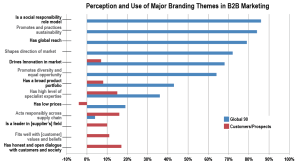Do you know what B2B prospects are looking for in a supplier? Do you know what B2B prospects want to hear? Is there an opportunity for mid-size B2B companies to brand around messages that bigger players miss?
Recently McKinsey did some research on branding themes among major B2B companies and answered some of these questions. The purpose of the resarch was to determine how well branding messages of global B2B players matched up to the interests of B2B customers.
McKinsey collected and analyzed public documents from 500+ global companies across six business sectors. The six sectors were:
- Banking and insurance
- Machines and components
- Utility services
- IT-related products and services
- Chemicals, commodities, and basic materials
- Telecommunications products and services
From this data set McKinsey identifed 13 branding themes that the largest companies promote in their messaging. Next McKinsey did a deeper analysis of the branding and advertising of the 90 largest global companies to see how they matched up to the overall list.
The 13 themes (ranked by usage for the Global 90 sample) are:
- Is a role model for social responsibility
- Promotes and practices sustainability
- Has global reach
- Shapes the direction of the market
- Is a driver of innovation
- Promotes diversity and equal opportunity
- Has a broad product portfolio
- Has a high level of specialist expertise
- Has low prices
- Acts responsibly across supply chain
- Honest, open dialogue with customers and society
- Fits well with [customer] values and beliefs
- Is a leader in [suppliers] field
Finally McKinsey surveyed more than 700 business executives to see how important each of the 13 themes was to potential buyers of B2B services.
 As you can see from this graph (click here for full-size image) there is a significant mismatch between what global B2B suppliers promote about their brands and what B2B customers care about.
As you can see from this graph (click here for full-size image) there is a significant mismatch between what global B2B suppliers promote about their brands and what B2B customers care about.
There are at least five lessons we can draw from this data.
Lesson 1: People and relationships are still far more important than branding.
Looking at the B2B customer responses no theme was considered important by more than 17% of customers. That’s not very many. That means one or more additional factors are driving business decisions.
McKinsey says their surveys show that personal interactions with sales reps are still the single most influential factor for B2B customers. Not to overstate the obvious but this means your sales force really is your most valuable branding tool – not a website, ad campaign, or marketing. It also means they are (certainly one of) your most valuable source of customer and competitor information (which we’ll get to in a moment).
Lesson 2: Big companies are missing the mark in branding.
Five of the Top Six branding themes among the Global 90 are completely irrelevant to customers and prospects. These guys are spending millions on marketing and are almost completely missing the boat. The single most important branding theme to customers – open and honest dialogue – gets zero play from the big marketers.
In fact, three of the eight themes customers care about get zero play and one – low pricing – actually has a negative perceptual impact.
Lesson 3: People don’t always value what they say they value.
Look at the Low Price ranking: -4%. In business very few admit to wanting suppliers who brand around low prices, but everyone wants the lowest price when it comes time to sign the deal.
Lesson 4: Gaps mean opportunities.
This mismatch between how big companies brand and what prospects care about is an opportunity. If you are a mid-size enterprise there is space here for real differentiation. Are you mimicking big-company propaganda in your marketing? Are you copying some of the big players, trying to take them on head-on? If so you should be branding differently, speaking directly to things B2B prospects value.
Branding isn’t the most important thing you can do, but it is not unimportant. Relationships are key but if you don’t have a relationship you need to make starting one as easy as possible on your sales staff. Your message can either help or hinder that effort. What does your marketing do?
Lesson 5: The sales force is an excellent source of customer and competitive information.
Competitive strategy needs real human insight and perspective. Your sales force is one of the most important sources of competitive intelligence, but only if they have the proper guidance and a supporting infrastructure to make that intelligence useful. Are you taking advantage of what your sales force can do for your competitive strategy? Over at Competitive Thinking Blog you’ll find more on how your sales force can become a stronger plank in your competitive platform.